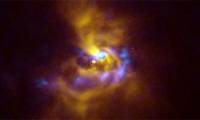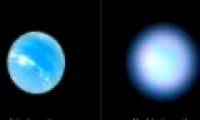
While tracking a star in the constellation of Cygnus, scientists were 'dazzled' by a sudden increase in light of up to 20 times due to the appearance of unique objects.

At present masses, fast-growing black holes can only detect a star the size of the Sun every day, according to researchers' calculations.

The huge telescope (VLT) of the Paranal Observatory in Chile captures an image of an exoplanet forming around the star AB Aurigae.

A space rock that has long been mistaken for asteroids may actually be a dwarf planet like Ceres or Pluto.

The telescope in Chile captures the image of galaxy NGC 3981 glowing with stars scattered around.

The Very Large Telescope (VLT) of the Southern European Observatory (ESO) has received the first light rays after activating the new adaptive optical mode.

Astronomers first discovered super-bright supernova explosions about a decade ago.

Astronomers use ESO's MUSE device on the Very Large Telescope in Chile to discover a strange star in NGC 3201 cluster.

The Very Large Telescope (VLT) was built in the Paranal Observatory area in the Atacama desert, northern Chile.
 While tracking a star in the constellation of Cygnus, scientists were 'dazzled' by a sudden increase in light of up to 20 times due to the appearance of unique objects.
While tracking a star in the constellation of Cygnus, scientists were 'dazzled' by a sudden increase in light of up to 20 times due to the appearance of unique objects. At present masses, fast-growing black holes can only detect a star the size of the Sun every day, according to researchers' calculations.
At present masses, fast-growing black holes can only detect a star the size of the Sun every day, according to researchers' calculations. The huge telescope (VLT) of the Paranal Observatory in Chile captures an image of an exoplanet forming around the star AB Aurigae.
The huge telescope (VLT) of the Paranal Observatory in Chile captures an image of an exoplanet forming around the star AB Aurigae. A space rock that has long been mistaken for asteroids may actually be a dwarf planet like Ceres or Pluto.
A space rock that has long been mistaken for asteroids may actually be a dwarf planet like Ceres or Pluto. The telescope in Chile captures the image of galaxy NGC 3981 glowing with stars scattered around.
The telescope in Chile captures the image of galaxy NGC 3981 glowing with stars scattered around. The Very Large Telescope (VLT) of the Southern European Observatory (ESO) has received the first light rays after activating the new adaptive optical mode.
The Very Large Telescope (VLT) of the Southern European Observatory (ESO) has received the first light rays after activating the new adaptive optical mode. Astronomers first discovered super-bright supernova explosions about a decade ago.
Astronomers first discovered super-bright supernova explosions about a decade ago. Astronomers use ESO's MUSE device on the Very Large Telescope in Chile to discover a strange star in NGC 3201 cluster.
Astronomers use ESO's MUSE device on the Very Large Telescope in Chile to discover a strange star in NGC 3201 cluster. The Very Large Telescope (VLT) was built in the Paranal Observatory area in the Atacama desert, northern Chile.
The Very Large Telescope (VLT) was built in the Paranal Observatory area in the Atacama desert, northern Chile.








 Why did the ancient Babylonian civilization perish? Was it because they considered 'that thing' a daily meal?
Why did the ancient Babylonian civilization perish? Was it because they considered 'that thing' a daily meal? Just discovered a 72km 'tear in the Earth', the world's second largest country is in fear of a tsunami attack
Just discovered a 72km 'tear in the Earth', the world's second largest country is in fear of a tsunami attack Top 7 facts about the hottest place in the world, where you can fry eggs at outdoor temperature
Top 7 facts about the hottest place in the world, where you can fry eggs at outdoor temperature The Qing Dynasty collapsed, what surname did 20,000 royal descendants change to to integrate into the new era?
The Qing Dynasty collapsed, what surname did 20,000 royal descendants change to to integrate into the new era? After 389 days in the Arctic, costing more than $160 million, hundreds of scientists brought back bad news: What was it?
After 389 days in the Arctic, costing more than $160 million, hundreds of scientists brought back bad news: What was it? How long does it take to fall in love with someone?
How long does it take to fall in love with someone? How much silver has ever been discovered in the world?
How much silver has ever been discovered in the world? How does an atomic bomb work?
How does an atomic bomb work?